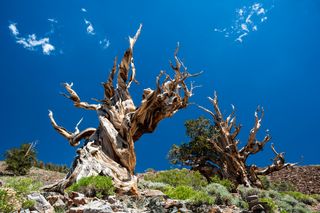
What's the Oldest Thing Alive Today?

The oldest living thing on Earth today is … well, it's controversial.
Let's back up. Figuring out the oldest thing alive requires defining "alive." That's not as easy as it might seem. If you want to be strict about finding the oldest living thing, you have to look for organisms that have been alive and active for their entire life spans — continuously metabolizing. A less rigid definition might allow for seeds or bacteria that have been dormant for ages but that can be revived. (Is a seed alive? Hmm…)
You also have to define what qualifies as an organism. Maybe you want to be stringent about it and limit your search to ancient individuals. Alternatively, you could count clonal organisms, like certain plants or fungal colonies. Those are made up of relatively young offshoots, but these are part of a continuously living being.
If it hasn't become obvious yet, this article isn't going to provide you with an address for the delivery of the world's most fiery birthday cake. It will, however, nominate some viable candidates for the oldest living thing on Earth. [See Photos of Earth's Oldest Living Things]
An old bristlecone: Longevity purists will appreciate the bristlecone pine (Pinus longaeva). The pines are single organisms (not clones) that live incredibly long lives. According to OLDLIST, a database of ancient trees, the oldest known living bristlecone is a 5,062-year-old tree in the White Mountains of California. The location has not been revealed in any greater detail, to prevent damage from curiosity seekers. When the tree germinated (in 3050 B.C.), humans were just beginning to construct Stonehenge. [Stunning Photos of Old Bristlecone Pines]
An even older spruce (sort of): If you'll accept clonal organisms in the contest for most ancient, look no further than Dalarna, Sweden. The province is home to a spindly spruce that has been cloning itself for 9,550 years. The tree currently sprouting is much younger, researchers reported in 2008, but it's genetically identical to the wood below it that dates back 9,550 years.
What makes the Dalarna spruce interesting is that it grew as a sprawling bush until the 1940s, when the warming climate spurred the trunk upward. The latest incarnation of the spruce stands straight and tall.
Sign up for the Live Science daily newsletter now
Get the world’s most fascinating discoveries delivered straight to your inbox.
A dying goliath: An even older clonal organism presides over south-central Utah. Pando is a quaking aspen (Populus tremuloides) colony thought to have been shooting up genetically identical trees for around 80,000 years, based on its current size. Pando covers about 107 acres (43.6 hectares), according to 2008 research, and was estimated in 1992 to weigh more than 13 million lbs. (6 million kilograms). Unfortunately, the U.S. Forest Service has reported that Pando is dying, as old shoots are not being replaced by new trees. The cause may be some combination of climate change, drought and insects, according to the Forest Service.
Getting smaller: Plants have a good claim on the ancient-organism crown, but some bacteria may threaten plants' reign. In 2007, researchers reported in the journal Proceedings of the National Academy of Sciences that they'd found 500,000-year-old bacteria that were quietly repairing their DNA while frozen in permafrost. That means the bacteria weren't dormant: They were active, barely, waiting for conditions to improve so that the organisms could start reproducing again.
Life in the slow lane: Permafrost may not be the only place where potential ancient life lurks. In 2013, researchers from the Integrated Ocean Drilling Program reported at the annual Goldschmidt Conference in Italy that they'd found microbes in 100-million-year-old sediments in the floor of the deep sea, according to the BBC. The microbes were reproducing once every 10,000 years, such a slow rate that scientists weren't sure if they could really call the microbes "alive."
Does dormancy count?: A dormant seed or bacteria doesn't exactly meet the criteria for "alive." Still, there are some incredible examples of very, very old things coming back to life after long periods of quiescence, and they're worth oohing and aahing over. In 1960, researchers Ralph Reiser and Paul Tasch claimed to have revived 200-million-year-old bacteria found in salt crystals in a salt mine in Hutchinson, Kansas. Modern contamination is always a possibility when seeking ancient life-forms, and very few of Reiser and Tasch's bacteria were viable. So even they said their results were only "suggestive."
However, in 2011, researchers at Binghamton University in New York state reported in the journal GSA Today that they had revived 34,000-year-old bacteria called Dunaliella from salt deposits in Death Valley, California. In 2009, another research group announced that they had revived 120,000-year-old microbes called Herminiimonas glaciei from nearly 2 miles (3 kilometers) below a glacier in Greenland.
Also, viruses aren't really alive, but scientists revived a permafrost-dwelling giant virus after 30,000 years of dormancy in 2014. Luckily, it was a virus that could infect only single-celled organisms.
Bored of bacteria? Plants can do the dormancy thing, too. In 2008, researchers reported that they had grown a Judean date (Phoenix dactylifera L.) from a 2,000-year-old seed found at an archaeological site in Israel. At 26 months old, the ancient sapling was 4 feet (1.2 meters) tall. Dubbed "Methuselah," the tree is the product of the oldest seed ever known to germinate. Imagine what its mother would have thought.
Original article on Live Science.

Stephanie Pappas is a contributing writer for Live Science, covering topics ranging from geoscience to archaeology to the human brain and behavior. She was previously a senior writer for Live Science but is now a freelancer based in Denver, Colorado, and regularly contributes to Scientific American and The Monitor, the monthly magazine of the American Psychological Association. Stephanie received a bachelor's degree in psychology from the University of South Carolina and a graduate certificate in science communication from the University of California, Santa Cruz.
